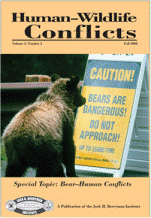Wildlife Damage Management, Internet Center for

Human–Wildlife Interactions
Date of this Version
Fall 2009
Document Type
Article
Abstract
aircraft collisions (i.e., bird strikes) are a major problem at airports worldwide, often because birds are attracted to airfields to feed on seeds, insects, or rodents that abound in the grassy areas near runways and taxiways. We compared an alternative ground cover, wedelia (Wedelia trilobata), to existing vegetation (control plots) on the airfield at Lihue Airport, Kauai, Hawaii, to determine if bird populations on the airport could be reduced by eliminating their forage base. We studied wedalia because it is a low-growing plant that did not need mowing, was easily established in plots, and out-competed other plants, resulting in a significant decrease in plant diversity. Thus, wedelia indirectly results in a decreased seed base for granivorous birds. Total invertebrate biomass was 41% lower in wedelia plots than in other vegetation plots (control plots). Rodent populations were 67% lower in wedelia than in control plots. Zebra doves (Geopelia striata), spotted doves (Streptopelia chinensis), and mannikins (Lonchura spp.) used wedelia plots significantly less than control plots, whereas, the lesser Pacific golden-plover (Pluvialis fulva) was unaffected. By reducing seed production, insect densities, and rodant populations, wedalia should be a useful ground cover on tropical airports to reduce bird use and, ultimately, bird strikes on the airport.


Comments
Published in Human–Wildlife Conflicts 3(2):226–236, Fall 2009. Published by Jack H. Berryman Institute http://www.berrymaninstitute.org/journal/index.html